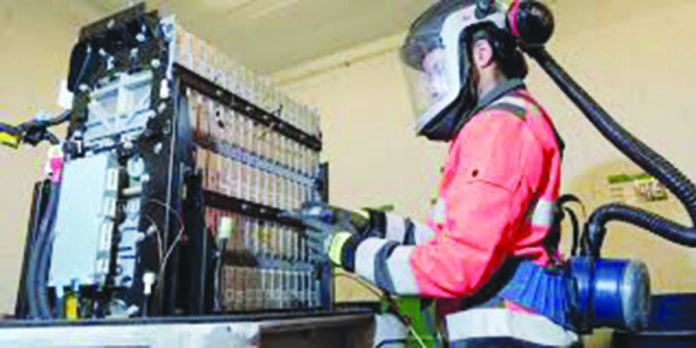The global movement towards sustainable electric vehicle battery recycling is gaining momentum as the world grapples with the challenges posed by climate change. In recent years, the electric vehicle market has experienced significant growth, driven by the adoption of cleaner and more sustainable transportation options. As electric vehicles become increasingly popular, the use of lithium-ion batteries has become widespread due to their ability to provide efficient and reliable power. However, with the increasing number of electric vehicles on the roads, a new challenge arises – the proper recycling and disposal of the large number of batteries that will soon reach the end of their service life.
The urgency to find an effective recycling strategy for waste electric vehicle batteries stems from the potential environmental pollution caused by improper disposal. As estimates suggest that by 2025, 11 million tons of waste lithium-ion batteries will flood the market without a proper recycling system in place, the need for action becomes evident. To effectively deal with climate change and reduce greenhouse gas emissions, it is essential to utilize existing battery resources efficiently to avoid pollution from toxic waste and ensure a steady supply of raw materials with minimal environmental costs.
The environmental hazards posed by waste electric vehicle batteries are considerable. When these batteries are damaged or subjected to extreme temperatures, they can become highly dangerous. The risk of thermal runaway, a phenomenon where the battery’s temperature increases uncontrollably due to a chemical reaction, leading to fires and explosions, is a significant concern. Fires caused by battery explosions can release toxic gases and pose severe risks to human health and the environment. Additionally, the transportation of electric vehicle batteries can contribute to global air pollution and negatively impact the environment. Emissions of pollutants such as PM10, SO2, and NOx from electric vehicle transportation, particularly lithium-ion batteries, can lead to acidification and eutrophication of water bodies, photochemical air pollution, and adverse effects on human health.
Furthermore, high concentrations of lithium from waste batteries can be harmful to aquatic organisms, plants, and animals. Low doses of lithium have been found to inhibit the proliferation and growth of aquatic organisms, disrupting the balance of ecosystems. Lithium accumulation in plants can lead to damage to their growth and development, impacting agriculture and the food chain. In humans, exposure to high levels of lithium can lead to various health issues, including effects on the nervous system, kidney, and endocrine system.
Addressing these environmental hazards and ensuring the sustainable development of the electric vehicle market requires effective battery recycling technologies. Cascade utilization is a valuable strategy that involves repurposing retired electric vehicle batteries for secondary uses in various applications. Approximately 70 percent of a battery’s capacity can still be utilized after it no longer meets the requirements for primary use in electric vehicles. These batteries can find applications in fields like energy storage, photovoltaic power generation, and low- and high-speed electric vehicles.
Addressing the challenges of battery recycling and development requires collaborative efforts from industry, governments, researchers, and consumers. By prioritizing research, innovation, and the adoption of sustainable practices, we can ensure that electric vehicles contribute to a cleaner and more sustainable world. Through responsible management, recycling, and the adoption of circular economy principles, we can pave the way for a future where electric vehicles play a vital role in achieving global climate goals and creating a more sustainable planet for generations to come.
Ultrasonic recovery is another promising technology for battery recycling. It utilizes high-power ultrasound to separate active materials from composite electrodes in a continuous flow process. This technology enables the electrode to delaminate within seconds, effectively removing valuable materials from the battery for recycling purposes.
As the demand for electric vehicles and energy storage continues to rise, researchers are exploring alternative battery technologies to address the potential shortage of lithium resources. Sodium-ion batteries have emerged as a promising candidate for next-generation batteries. Sodium, unlike lithium, is widely available and its chemical composition is similar to lithium, making it a cost-effective and sustainable alternative. By replacing lithium-ion batteries with sodium-ion batteries, it may be possible to address concerns about lithium resource availability and create a more sustainable battery market.
However, challenges remain in developing optimized electrode materials and electrolytes with stable sodium storage capacity. Research efforts are ongoing to unlock the full potential of sodium-ion batteries and ensure their commercial viability in the future.
Efforts are also being made to improve the recycling process of lithium-ion batteries. One approach involves the development of closed-loop recycling systems, where manufacturers take back used batteries and recycle them to produce new batteries. This approach ensures that valuable materials are reclaimed, reducing the need for raw materials and minimizing waste. In addition to closed-loop recycling, there are efforts to improve the recycling efficiency through advanced sorting and separation technologies. These technologies can enhance the recovery of valuable materials from waste batteries, making the recycling process more cost-effective and environmentally friendly.
The adoption of electric vehicles not only presents environmental challenges but also creates opportunities for the development of a circular economy. In a circular economy, the focus is on reducing waste and maximizing the value of resources by keeping products and materials in use for as long as possible. The recycling and repurposing of waste electric vehicle batteries are crucial components of this circular economy approach. By effectively recycling and reusing battery materials, we can reduce the demand for new raw materials, minimize environmental impacts, and create economic value.
In addition to recycling technologies, advancements in battery design and manufacturing can also contribute to more sustainable electric vehicle batteries. Designing batteries with ease of disassembly and recyclability in mind can simplify the recycling process and reduce the environmental burden. Moreover, the use of sustainable and eco-friendly materials in battery manufacturing can further enhance the overall sustainability of electric vehicles.
Promoting consumer awareness and responsibility is also vital in ensuring the success of battery recycling efforts. Educating consumers about the importance of proper battery disposal and encouraging them to participate in battery recycling programmes can significantly improve recycling rates. Government policies and regulations can play a crucial role in supporting battery recycling initiatives by establishing clear guidelines and incentives for manufacturers, consumers, and recycling facilities.
The global movement towards sustainable electric vehicle battery recycling is critical for mitigating the impact of climate change and promoting a cleaner and greener future. Proper recycling and disposal of waste electric vehicle batteries are essential to reduce environmental pollution and protect human health. Cascade utilization and ultrasonic recovery technologies offer promising solutions for maximizing the value of retired electric vehicle batteries and reducing waste. Moreover, the development of alternative battery technologies, such as sodium-ion batteries, holds the potential to revolutionize the battery market, providing a more abundant and cost-effective alternative to lithium-ion batteries.
Addressing the challenges of battery recycling and development requires collaborative efforts from industry, governments, researchers, and consumers. By prioritizing research, innovation, and the adoption of sustainable practices, we can ensure that electric vehicles contribute to a cleaner and more sustainable world. Through responsible management, recycling, and the adoption of circular economy principles, we can pave the way for a future where electric vehicles play a vital role in achieving global climate goals and creating a more sustainable planet for generations to come.























